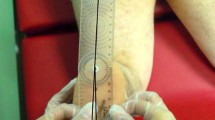Abstract
Background
Any intraoperative rotational malalignment during intramedullary nailing (IMN) of femoral shaft fractures will become permanent. We hypothesized that rotational malalignment of the femur and its compensatory biomechanics may induce problems in the hip, knee, patellofemoral and ankle joints. We purposed to clarify the influence of a femoral rotational malalignment of ≥10° on daily activities.
Methods
Twenty-four femoral shaft fracture patients treated with closed antegrade IMN were included. At last follow-up, to reveal any rotational malalignment, computerized tomography (CT) scans of both femurs (injured and uninjured sides) were examined. The patient groups with or without CT-detected true rotational malalignment ≥10° were compared with respect to the activity scores.
Results
Ten of the 24 patients (41.7 %) had a CT-detected true rotational malalignment of ≥10° compared with the unaffected side. The AOFAS scores were 100.00 for all of the patients. LKS, WOMAC knee, and WOMAC hip scores were significantly decreased in the patients with rotational malalignment compared to those without. Patients without rotational malalignment tolerated climbing stairs significantly better than those with rotational malalignment. Patients who could not tolerate climbing stairs were consistently complaining of anterior knee pain.
Conclusions
A femoral rotational malalignment of ≥10° is symptomatic for the patients, and the hip, knee, and patellofemoral joints were affected. Because of the possibly altered joint loadings and biomechanics, these could render patients prone to degenerative joint disease. In addition, due to the high rates of rotational malalignment after femoral shaft fracture and consequent malpractice claims, it is important for surgeons to be more aware of rotational alignment during surgery.

Similar content being viewed by others
References
Winquist RA, Hansen ST Jr, Clawson DK (1984) Closed intramedullary nailing of femoral fractures. A report of five hundred and twenty cases. J Bone Joint Surg Am 66(4):529–539
Tornetta P, Ritz G, Kantor A (1995) Femoral torsion after interlocked nailing of unstable femoral fractures. J Trauma 38:213–219
Wolinsky P, Tejwani N, Richmond JH, Koval KJ, Egol K, Stephen DJ (2002) Controversies in intramedullary nailing of femoral shaft fractures. Review. Instr Course Lect 51:291–303
Deshmukh RG, Lou KK, Neo CB, Yew KS, Rozman I, George J (1998) A technique to obtain correct rotational alignment during closed locked intramedullary nailing of the femur. Injury 29(3):207–210
Brouwer KJ, Molenaar JC, van Linge B (1981) Rotational deformities after femoral shaft fractures in childhood: a retrospective study 27–32 years after the accident. Acta Orthop Scand 52:81–89
Jaarsma RL, Ongkiehong BF, Grüneberg C, Verdonschot N, Duysens J, van Kampen A (2004) Compensation for rotational malalignment after intramedullary nailing for femoral shaft fractures. An analysis by plantar pressure measurements during gait. Injury 35(12):1270–1278
Bråten M, Terjesen T, Rossvoll I (1993) Torsional deformity after intramedullary nailing of femoral shaft fractures. Measurement of anteversion angles in 110 patients. J Bone Joint Surg Br 75(5):799–803
Jaarsma RL, Pakvis DF, Verdonschot N, Biert J, van Kampen A (2004) Rotational malalignment after intramedullary nailing of femoral fractures. J Orthop Trauma 18(7):403–409
Salem KH, Maier D, Keppler P, Kinzl L, Gebhard F (2006) Limb malalignment and functional outcome after antegrade versus retrograde intramedullary nailing in distal femoral fractures. J Trauma 61(2):375–381
Yildirim AO, Aksahin E, Sakman B, Kati YA, Akti S, Dogan O, Ucaner A, Bicimoglu A (2013) The effect of rotational deformity on patellofemoral parameters following the treatment of femoral shaft fracture. Arch Orthop Trauma Surg 133(5):641–648
Jeanmart L, Baert AL, Wackenheim A (1983) Computer tomography of neck, chest, spine and limbs. Atlas of pathologic computer tomography, vol 3. Springer, New York
Lee TQ, Anzel SH, Bennett KA, Pang D, Kim WC (1994) The influence of fixed rotational deformities of the femur on the patellofemoral contact pressures in human cadaver knees. Clin Orthop Relat Res 302:69–74
Gugenheim JJ, Probe RA, Brinker MR (2004) The effects of femoral shaft malrotation on lower extremity anatomy. J Orthop Trauma 18:658–664
Moussa M (1994) Rotational malalignment and femoral torsion in osteoarthritic knees with patellofemoral joint involvement. A CT scan study. Clin Orthop Relat Res 304:176–183
Eckhoff DG (1994) Effect of limb malrotation on malalignment and osteoarthritis. Orthop Clin North Am 25:405–414
Kim JJ, Kim E, Kim KY (2001) Predicting the rotationally neutral state of the femur by comparing the shape of the contralateral lesser trochanter. Orthopedics 24(11):1069–1070
Jaarsma RL, Verdonschot N, van der Venne R, van Kampen A (2005) Avoiding rotational malalignment after fractures of the femur by using the profile of the lesser trochanter: an in vitro study. Arch Orthop Trauma Surg 125(3):184–187
Kendoff D, Citak M, Gardner MJ et al (2007) Navigated femoral nailing using noninvasive registration of the contralateral intact femur to restore anteversion. Technique and clinical use. J Orthop Trauma 21:725–730
Thoresen BO, Alho A, Ekeland A, Strømsøe K, Follerås G, Haukebø A (1985) Interlocking intramedullary nailing in femoral shaft fractures. A report of forty-eight cases. J Bone Joint Surg Am 67(9):1313–1320
Vitale MA, Choe JC, Sesko AM, Hyman JE, Lee FY, Roye DP Jr, Vitale MG (2006) The effect of limb length discrepancy on health-related quality of life: is the ‘2 cm rule’ appropriate? J Pediatr Orthop B 15(1):1–5
Conflict of interest
There was no support for the work in the form of grants, equipment, drugs, or any combination of these, and no funds were received. The article is an original contribution that has been read and approved by all co-authors, and neither has been published previously nor is being submitted elsewhere. Each author certifies that he has no commercial associations (e.g., consultancies, stock ownership, equity interest, patent/licensing arrangements) that might pose a conflict of interest in connection with the submitted article. Each of the authors has read and concurs with the content in the final manuscript.
Author information
Authors and Affiliations
Corresponding author
Rights and permissions
About this article
Cite this article
Karaman, O., Ayhan, E., Kesmezacar, H. et al. Rotational malalignment after closed intramedullary nailing of femoral shaft fractures and its influence on daily life. Eur J Orthop Surg Traumatol 24, 1243–1247 (2014). https://doi.org/10.1007/s00590-013-1289-8
Received:
Accepted:
Published:
Issue Date:
DOI: https://doi.org/10.1007/s00590-013-1289-8




